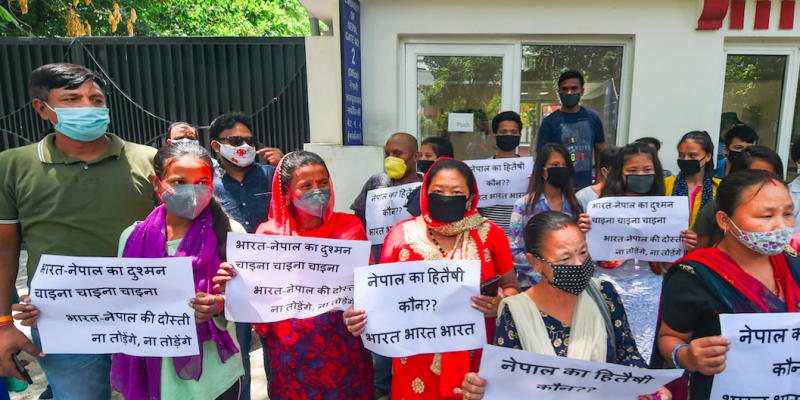New Delhi: A day after Nepal Prime Minister K.P. Sharma Oli ruffled Indian feathers with a statement alleging that India has culturally appropriated Ram, the Nepal foreign ministry issued a clarification saying he did not mean to hurt sentiments and his words were a call for further research into Ramayana’s ‘cultural geography’.
The Nepali PM’s latest statement was made at a programme on Monday, July 13, to mark the 206th birth anniversary of Nepali poet Bhanu Bakta Acharya, who had translated the Ramayana from Sanskrit to Nepali.
Oli’s statement has got the expected visibility in India, where he is viewed as the main hurdle towards fostering smoother India-Nepal relations by a certain section of the media. Indian television channels have been unrelenting in what can only be called a smear campaign against Oli. One channel even aired a 16-minute section about Oli being ‘honey trapped’ by the Chinese envoy to Kathmandu. This led to a ban by Nepali cable distributors on Indian news channels .
“We have been suppressed culturally. Facts have been twisted. Even today, we believe that Sita was married to an Indian prince, Ram. We gave her not to an Indian, but to the one from Ayodhya. Ayodhya is a village that lies to the west of Birgunj,” Oli said at the function held at his official residence in Baluwatar.
Also read: Ayodhya: Once There Was A Mosque
The city of Ayodhya is an important touchstone in India’s political map, since the Ram Temple issue has been a key electoral agenda of the ruling party. The Supreme Court last year gave a final judgement that cleared the deck for the building of the Ram temple at Ayodhya.

A statue of Ram in Ayodhya. Photo: Reuters/Danish Siddiqui
The Nepal foreign ministry’s press note issued on Tuesday evening said that the remarks by “the Prime Minister are not linked to any political subject and have no intention at all to hurt the feeling and sentiment of anyone”.
It further stated that Prime Minister Oli was referring to various tales associated with the Ramayana. “As there have been several myths and references about Shri Ram and the places associated with him, the Prime Minister was simply highlighting the importance of further studies and research of the vast cultural geography the Ramayana represents to obtain facts about Shri Ram, Ramayana and the various places linked to this rich civilisation”.
The Nepal foreign ministry added that Oli’s words were “not meant to debasing the significance of Ayodhya and the cultural value it bears”.
Oli’s statement was certainly not a passing remark. He spent considerable time on the subject.
“There is a fierce debate about Ayodhya. In fact, Ayodhya lies in Thori, which is west of Nepal’s Birgunj, and the Pandit who performed Putresthi Yagya [a religious ceremony organised to seek divine blessings to have children] after there were no children from King Dasarath was from Ridi [in Nepal]…Therefore, the child [Ram] is also not Indian. The place [Ayodhya] is not in India either,” he said, as quoted by Republica.
Also read: India-Nepal War of Words Continues Over Offers, Non-Offers of Border Talks
The reason that Oli gave for the theory that Ram was from present Nepal was the considerable distance between Ayodhya in India and his wife, Sita’s birthplace at Janakpur in Nepal, which the Nepalese prime minister felt would have been impossible to surmount in ancient times.
“If Janakpur was here and Ayodhya was there [ in India], how would one know that there was a princess eligible for marriage. There was neither telephone, nor mobile phone. It was just impossible to know about the match,” he said. Oli theorised that the marriage would have taken place only if those two places were not far from each other.
He seemed to be aware of the provocative nature of his remarks. “But it is not possible to debate here. There could be one attack after another,” he stated.
Nepal has always been sensitive of having a separate cultural identity from its bigger neighbour. For example, Nepali politicians and civil society have been particularly vigilant about reiterating that Lord Buddha was born in Nepal, irked by remarks that the founder of Buddhism was only linked with India.

Nepal’s Prime Minister Khadga Prasad Sharma Oli (L) shakes hands with his Indian counterpart Narendra Modi. Photo: Reuters
Oli’s latest statement is only one in a long line of recent remarks which have garnered attention in India.
Recently, he had accused the Indian embassy of having been behind the factional crisis in the ruling Nepal Communist Party which threatens his office. He had indicated that India is behind the political machinations as New Delhi had been unhappy with Kathmandu over the constitutional amendment updating the outline of Nepal’s political map. It now includes territories claimed by India.
Oli won the last general elections on an ultra-nationalist platform which has been energised following a so-called blockade by the Indian government. While relations with India had been seemingly remained fine in Oli’s early years, there has been renewed friction with Nepal first taking objection over a political map issued by India in November 2019.
Also read: The Kalapani Imbroglio: Has India Pushed Nepal Too Far?
While Nepal has been calling for high-level talks on resolving the territorial disputes in two sections of the border, New Delhi has asserted that it will be ready for discussion only after the coronavirus pandemic is over.
So far, India has kept a studious silence over the various statements made by Prime Minister Oli, with the Ministry of External Affairs only reiterating that the people-to-people relations between the two countries remain strong.
Incidentally, Nepal government, in its press communique, recalled that the two prime ministers of India and Nepal had launched a Ramayana circuit, which included a Janakpur-Ayodhya passenger bus service, in May 2018.
The press release also mentioned the tradition of Bibaha Panchami when a symbolic marriage procession from Ayodhya to Janakpur takes place every year. “These facts signify the bond of time honoured cultural affinity between our two countries and peoples,” said the Nepal foreign ministry.
Note: The article has been updated with the Nepal foreign ministry’s response.




